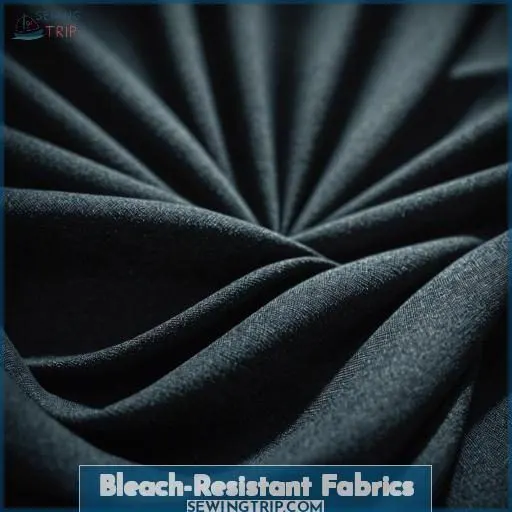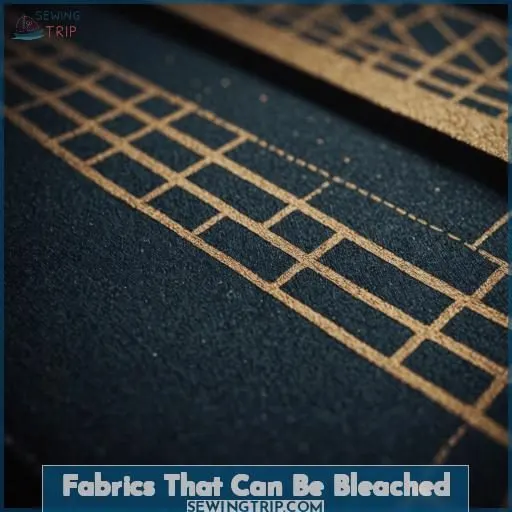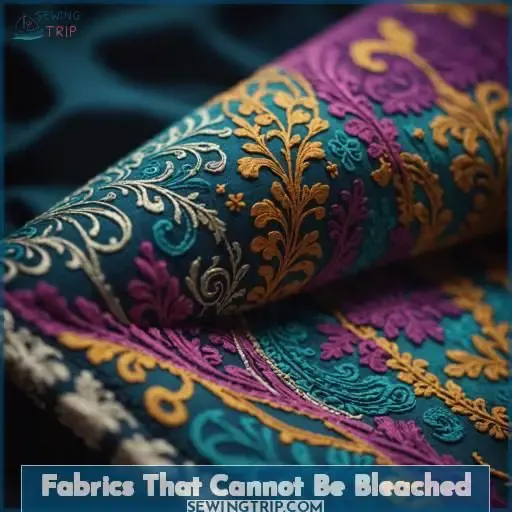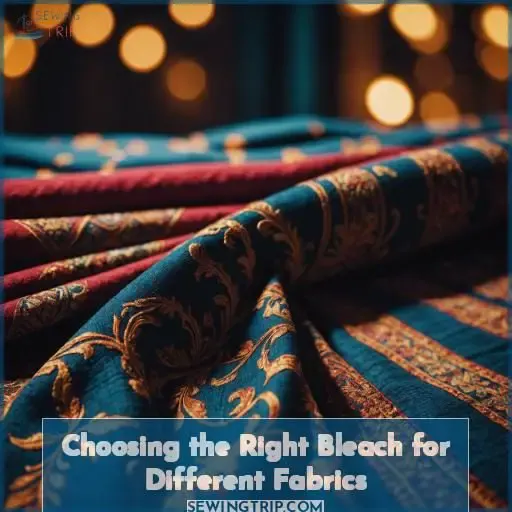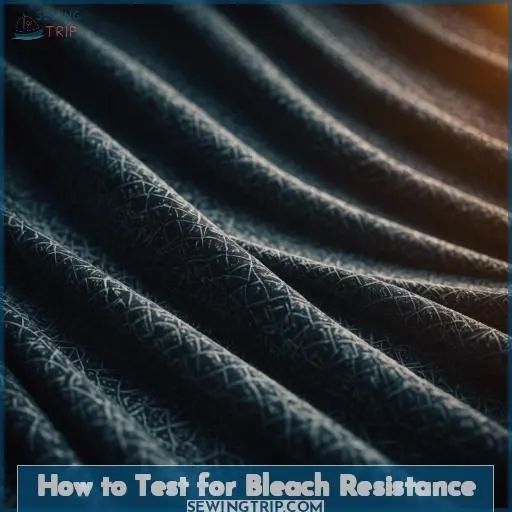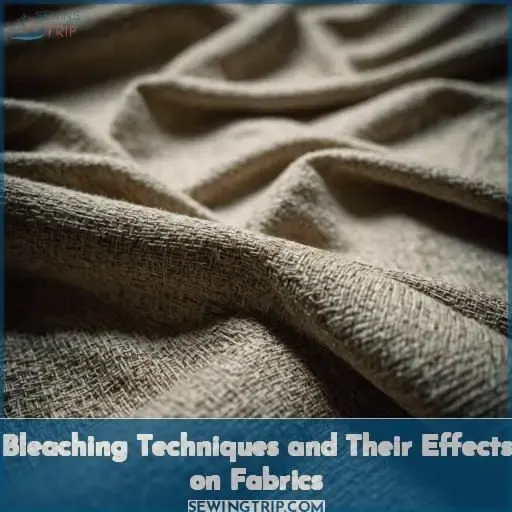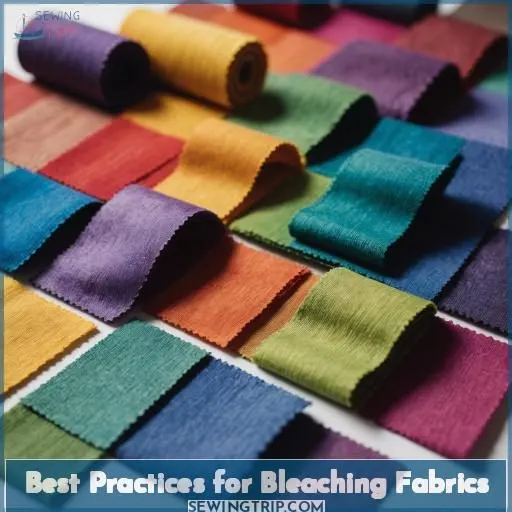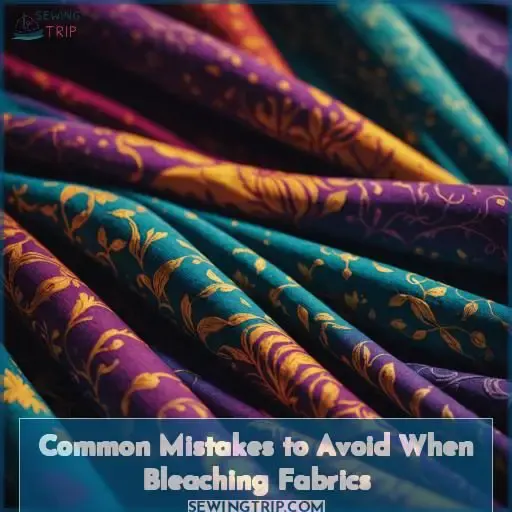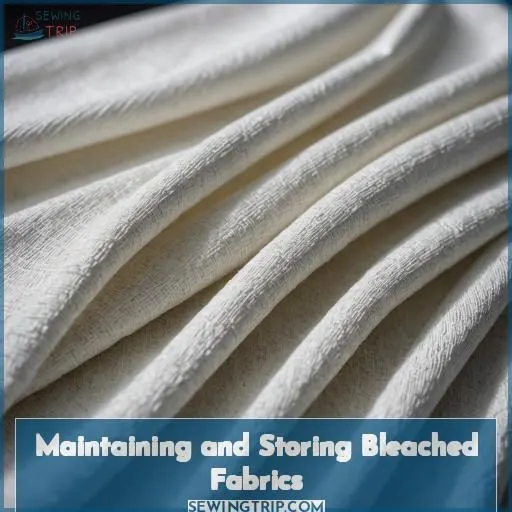This site is supported by our readers. We may earn a commission, at no cost to you, if you purchase through links.
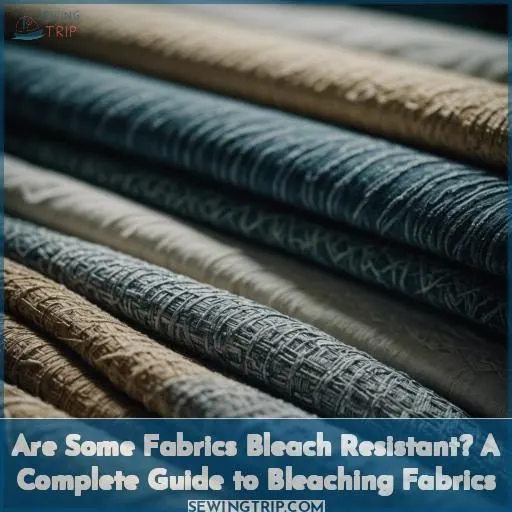
On the other hand, cellulose-based fabrics like cotton, linen, and rayon are ideal for bleaching to whiten and brighten. However, bleach damages protein fibers like wool and silk. Spandex also degrades when exposed to bleach.
When bleaching fabrics, choose the appropriate bleach strength, test first on a hidden area, and follow proper safety precautions. To learn more about identifying bleach-resistant materials and proper bleaching techniques, continue on.
Table Of Contents
- Key Takeaways
- Are Some Fabrics Bleach Resistant?
- Bleach-Resistant Fabrics
- Fabrics That Can Be Bleached
- Fabrics That Cannot Be Bleached
- Choosing the Right Bleach for Different Fabrics
- How to Test for Bleach Resistance
- Bleaching Techniques and Their Effects on Fabrics
- Best Practices for Bleaching Fabrics
- Common Mistakes to Avoid When Bleaching Fabrics
- Maintaining and Storing Bleached Fabrics
- Frequently Asked Questions (FAQs)
- Conclusion
Key Takeaways
- Synthetic fibers like polyester, nylon, and acrylic are inherently bleach-resistant, while natural fibers like cotton, linen, and rayon are more vulnerable to bleach.
- Fabrics that can be safely bleached include cotton, linen, hemp, and rayon, while protein fibers like wool and silk, as well as spandex, should not be bleached.
- It is crucial to test for colorfastness before bleaching any fabric, and to use the appropriate bleach type and strength to avoid damage.
- Proper bleaching techniques, such as diluting the bleach and rinsing thoroughly, are essential to maintain the integrity and appearance of bleached fabrics.
Are Some Fabrics Bleach Resistant?
Yes, some fabrics are bleach resistant. Fabrics like polyester, nylon, and acrylic can withstand bleaching without significant damage, while natural fibers like cotton, linen, and silk are more susceptible to bleach damage.
Bleach-Resistant Fabrics
Regarding fabric care, certain materials exhibit superior resistance to chlorine bleach as compared to others. Synthetic fibers such as polyester, nylon, and acrylic possess inherent bleach-resistance, owing to their color being embedded during the dyeing process with fiber-reactive dyes. Consequently, you can confidently employ chlorine bleach on these fabrics without apprehension about color loss or degradation.
Conversely, natural fibers like cotton, linen, and rayon are more vulnerable to the oxidative effects of bleach, leading to color fading and fabric deterioration. To safeguard the color and integrity of these fabrics, it’s prudent to utilize alternative bleaching agents or refrain from bleaching entirely. Comprehending the bleach-resistance of various materials is imperative for maintaining the pristine appearance of your garments.
Fabrics That Can Be Bleached
When choosing fabrics for bleaching, it’s crucial to consider their compatibility with bleach’s active ingredient, sodium hypochlorite. Fabrics like cotton, linen, hemp, and rayon are ideal, as their cellulose-based fibers quickly absorb and react with the bleaching agent.
- These fabrics can endure the oxidizing power of bleach, allowing you to effectively remove stains, whiten, and brighten the material.
- Bleaching generally won’t alter the texture or pattern of these fabrics, making them suitable for a wide range of applications.
- However, be aware that bleaching may still cause some color changes, potentially shifting darker shades towards lighter, more vibrant hues.
- For optimal results, always check care labels and perform spot tests before fully submerging garments in a bleach solution.
- Choose oxygen-based bleaches or whitening detergents to preserve the color of more delicate fabrics.
Fabrics That Cannot Be Bleached
There are certain fabrics you can’t bleach with chlorine bleach.
These include wool, silk, mohair, leather, and fabrics with spandex.
Bleach will damage protein fibers like wool and silk, leaving them dry, stiff, and prone to breakage.
Spandex also degrades when exposed to bleach.
If you accidentally bleach non-colorfast fabrics, the colors may bleed or fade.
Consider using bleach alternatives like oxygen-based bleaches, which are gentler but less effective.
Still, it’s best to avoid bleaching these fabrics altogether to preserve their quality and appearance.
If colors have faded, explore color restoration methods that don’t rely on harsh bleaching agents.
Choosing the Right Bleach for Different Fabrics
To choose the right bleach for different fabrics, you’ll need to understand bleach types and perform colorfastness tests. Chlorine bleach is strongest for white cottons, while oxygen bleach is gentler for colorfast items; checking labels and testing a hidden area first prevents damage.
Fabric Testing
Before bleaching any fabric, it’s essential to test for colorfastness. Apply a small drop of diluted bleach to a concealed area and wait a minute. If there’s no color change, the fabric is bleach-safe. This simple test helps avert accidental damage from improper bleach use, ensuring your fabrics remain vibrant and undamaged during disinfection.
Bleach Types
Regarding the selection of an appropriate bleach, you have several alternatives. Chlorine-containing bleach is the most powerful, economical, and sanitizing option. Oxygen bleach is more delicate and can be employed in warm-water pre-soaking. Optical brighteners in laundry detergents can also enhance the illumination of fabrics. Ensure that you:
- Verify the fabric’s composition
- Assess its resistance to fading
- Adhere to the instructions provided by the manufacturer
- Use bleach judiciously to prevent harm
Colorfastness
To test a fabric’s colorfastness, apply a diluted bleach solution to an inconspicuous area and check for color changes.
Look for colorfastness symbols on the care label – a triangle indicates bleach-safe.
Colorfastness can vary by fiber type, dye, and processing.
Follow industry standards for evaluating colorfastness.
Bleaching can discharge or reverse-dye fabrics, so exercise caution and test first.
Optical brighteners in detergents can also affect colorfastness.
How to Test for Bleach Resistance
Before you start bleaching your fabrics, it’s essential to test for colorfastness. This simple process can save you from expensive errors and guarantee your garments look their best. First, collect a small, hidden sample of the fabric and mix a solution of 2 teaspoons of bleach per 1/4 cup of water. Apply a drop of the solution to the fabric and wait 1 minute. Rinse and blot the area dry. If the color remains the same, the fabric is colorfast. However, if the color fades or shifts, it’s best to avoid using regular bleach and choose a milder, color-safe alternative instead.
- Perform a bleach test on hidden areas to check for colorfastness.
- Use the right bleach strength for your fabric – too much can damage it.
- Explore bleach alternatives like oxygen-based products for delicate fabrics.
- Pay attention to any color changes, as they indicate the fabric isn’t colorfast.
- Always prioritize safety by wearing gloves and working in a well-ventilated area.
Bleaching Techniques and Their Effects on Fabrics
Regarding fabric bleaching, the selected technique significantly influences the outcome. For example, applying household bleach directly can result in uneven coloration and potential harm. Conversely, spraying a diluted bleach solution provides a more controlled and gradual effect.
| Bleaching Technique | Effect on Fabric |
|---|---|
| Direct Pouring | Uneven discoloration, potential damage |
| Spray Application | Controlled, gradual effect |
| Stenciling | Precise patterns and designs |
| Immersion | Uniform color change |
| Brushing | Targeted application, textural changes |
Regardless of the method used, testing for colorfastness and monitoring the fabric’s condition are essential to avoid irreversible damage. Considering bleach alternatives, such as oxygen-based solutions, may be a safer choice for delicate or light-colored fabrics.
Best Practices for Bleaching Fabrics
Now that you comprehend the consequences of bleaching on various fabrics, it’s time to investigate the optimal techniques for bleaching your garments safely and efficiently. Correct bleaching method is crucial for safeguarding the structure of your fabrics. Before employing any bleach, always inspect the care label and assess colorfastness.
Next, adhere to these four fundamental steps for bleaching proficiency:
- Guarantee adequate ventilation and don protective gloves while handling bleach.
- Utilize the appropriate quantity of bleach – excessive bleach can harm fabrics.
- Immerse colorfast fabrics in a diluted bleach mixture for the prescribed duration.
- Extensively rinse bleached items to eliminate any leftover chemicals.
Common Mistakes to Avoid When Bleaching Fabrics
When bleaching fabrics, there are several common mistakes you’ll want to avoid. First, be mindful of bleach safety – always wear gloves and work in a well-ventilated area to prevent skin irritation or respiratory issues. Subsequently, don’t overdo it with the bleach. Too much can severely damage delicate fabrics like wool or silk. Instead, opt for bleach alternatives like oxygen-based whiteners that are gentler on clothes.
Another pitfall is improper bleach disposal. Never pour undiluted bleach down the drain, as it can corrode pipes and release toxic fumes. Instead, dilute it with water before discarding. Finally, be cautious of bleach stains – they can be tricky to remove and may permanently discolor your garments. When in doubt, test a small, inconspicuous area first. With these tips, you can safely and effectively bleach your fabrics.
Maintaining and Storing Bleached Fabrics
After bleaching your fabrics, it’s essential to properly maintain and store them to extend their lifespan.
Bleach has the potential to damage fabrics over time, so be aware of fiber deterioration.
Store bleached items in a cool, dry environment out of direct sunlight to prevent color loss.
Avoid folding or wrinkling bleached fabrics, as this can result in permanent discoloration.
When washing bleached clothes, use a mild detergent and abstain from excessive bleaching, as this can cause colors to alter towards red, pink, yellow, or brown hues.
With appropriate care, your bleached fabrics can maintain their vibrant shades and structural integrity for an extended period.
By adhering to these simple storage methods, you’ll preserve the optimal appearance of your bleached items.
Frequently Asked Questions (FAQs)
How does bleach affect the durability of fabrics?
You bet your trendy tops – bleach wreaks havoc on delicate fabrics. Unlike sturdy cotton, silk or wool dissolves, leaving your outfit in tatters. But hey, maybe distressed is the new chic?
Can bleach be used to remove stubborn stains?
Yes, you can use bleach to treat stubborn stains. The strong oxidizing agent breaks down tough, set-in stains and brightens fabric. However, test fabrics first for colorfastness before applying bleach, as it can damage certain materials.
What are the environmental impacts of using bleach?
You might think bleach is harmless, but it can have severe environmental impacts. When released into water systems, bleach’s toxic compounds threaten aquatic life and contaminate drinking supplies. Using environmentally-friendly alternatives protects our ecosystems and future.
How can I safely dispose of bleach-contaminated fabrics?
You’ll want to double-bag bleach-stained items, seal tightly, and discard with your regular trash pickup. Don’t reuse bags or containers beforehand.
Are there any alternatives to bleach for whitening clothes?
You’ve got options beyond bleach! Oxygen-based products, vinegar, or sunshine offer milder, eco-friendly whitening. For tough stains, mixing baking soda with peroxide creates a powerful yet fabric-safe paste.
Conclusion
In summary, becoming proficient in the art of bleaching fabrics necessitates comprehending that certain fabrics resist bleaching while others do not.
By judiciously selecting the suitable bleach type, examining for colorfastness, and adhering to appropriate methods, you can rejuvenate fabrics without causing harm.
Bear in mind, a little expertise greatly contributes to realizing your desired outcomes when working with bleach-resistant materials.

